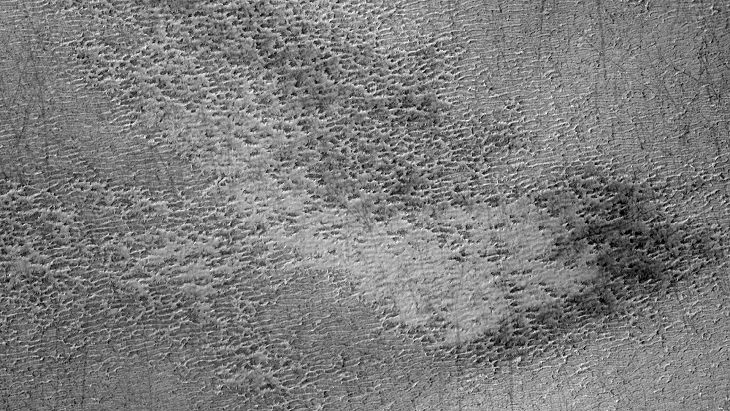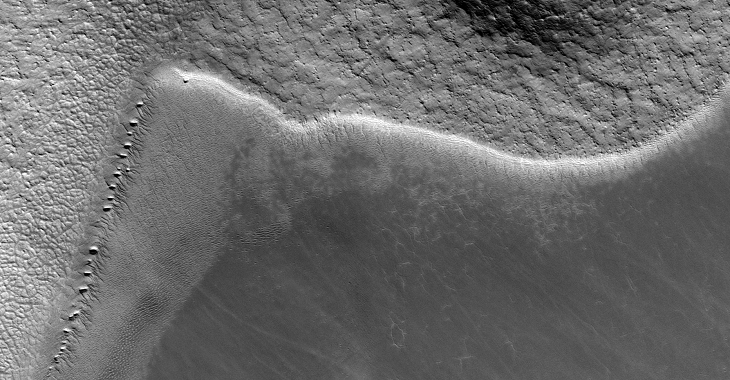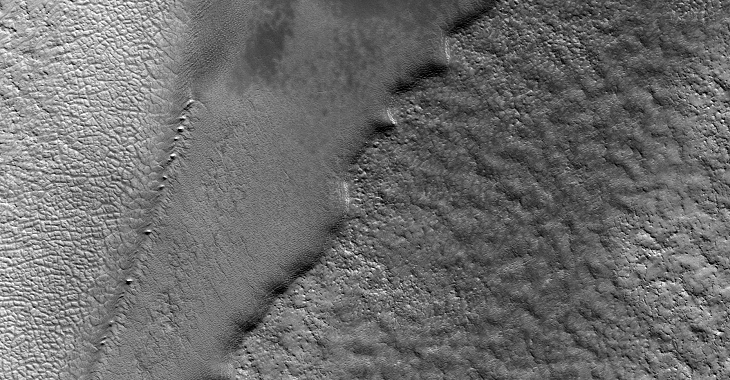On 25 July 2018 the ESA announced that it’s Mars Express Orbiter discovered a huge liquid water lake under the Martian surface near the South Pole using its on board radar.

About 1000 km to the west, in an MOC photograph (M0901354) taken by NASA in 1999, we can see what appears to be a lake surrounded by vegetation as well as what looks like a long, straight, artificial shore-line to the West with equally spaced and sized anomalies in a straight line.

A MRO HiRISE photograph (ESP_023024_1010) taken of the same area about 12 years later shows the lake, however it seems it has either dried up or frozen over. The surrounding vegetation also seems to have died and vanished.
I speculate that due to the pressure Elon Musk’s SpaceX and their race to Mars is placing the agencies involved in a decades long cover up, the truth is being revealed in a slow, soft disclosure fashion.
I further speculate that we will soon hear that liquid water has been discovered on the Martian surface.
Recent disclosure/confirmation events:
Here is a list of the latest disclosure or confirmation events that have reached mainstream news recently, note the short time frame:
- 16 December 2017: Glowing Auras and ‘Black Money’: The Pentagon’s Mysterious U.F.O. Program: https://www.nytimes.com/2017/12/16/us/politics/pentagon-program-ufo-harry-reid.html
- 7 June 2018: Curiosity Rover Finds Ancient ‘Building Blocks for Life’ on Mars: https://www.space.com/40819-mars-methane-organics-curiosity-rover.html
- 18 June 2018: President Trump directs Defense Department to ‘immediately begin the process’ of establishing ‘space force’ as sixth military branch: https://www.cnbc.com/2018/06/18/president-trump-directs-pentagon-defense-department-to-immediately-being-the-process-of-establishing-space-force-as-sixth-military-branch.html
- 25 July 2018: Mars Express detects liquid water hidden under planet’s south pole: http://www.esa.int/Our_Activities/Space_Science/Mars_Express/Mars_Express_detects_liquid_water_hidden_under_planet_s_south_pole
Underground Lake found on Mars:
The following MRO CTX photograph (F12_040281_0982_XN_81S165W) shows the general area in which the ESA discovered the underground liquid water lake:


Lake and vegetation found on Mars:
The two photographs analysed below show what appears to be a lake on the Martian surface.
The first photograph (M09-01354) shows what looks like liquid water and vegetation surrounding the lake.
.gif)
The second photograph (ESP_023024_1010) taken about 12 years later appears to show a dried up lake bed and it looks like the vegetation surrounding it has died.
The following images show a smaller lake located to the north in this CTX photograph:



The following images show a larger lake located to the south in this CTX photograph:










Upon closer inspection it looks like the shore-line of the larger lake in the earlier photograph is narrower than in the second photograph indicating the presence of might very well be water, therefore the deduction can be made that the shore-line being wider in the second photograph is as a result of the lack of water.
The vegetation may have died or dried out due to a seasonal change, e.g. being winter at the time the second photograph was taken. We have seen dramatic changes on the Martian surface during summer months when liquid water is seen seeping out of the sand and running down gullies, etc. It might be that the vegetation may return during summer months on Mars.
Original NASA sources:
Underground Water:
http://viewer.mars.asu.edu/planetview/inst/ctx/F12_040281_0982_XN_81S165W
Lake with vegetation:
http://asimov.msss.com/moc_gallery/m07_m12/images/M09/M0901354.html
https://www.uahirise.org/ESP_023024_1010
News articles:
Mars Express detects liquid water hidden under planet’s south pole: http://www.esa.int/Our_Activities/Space_Science/Mars_Express/Mars_Express_detects_liquid_water_hidden_under_planet_s_south_pole
Radar evidence of subglacial liquid water on Mars: http://science.sciencemag.org/content/early/2018/07/24/science.aar7268.full
Elon Musk responds to Boeing’s claim it will beat SpaceX to Mars: ‘Do it’ https://www.cnbc.com/2018/06/01/elon-musk-responds-to-boeings-claim-it-will-beat-spacex-to-mars.html
My YouTube video featuring ‘Huge Liquid Water Lake found on Mars (soft disclosure appears to be escalating):’
Subscribe to my YouTube channel and turn on notifications to be notified when new videos are uploaded.
Also visit Twitter page @RaptorZN_.
Disclaimer:
Images saved from within HiView or CTX viewer do not include image scale indicators. The image scale indicators I include in images are based on the official resolutions provided by NASA and although I strive to be as accurate as possible there may be slight deviations from the actual scale. Image scale indicators are included as a size approximation tool only.
Geometry lines are mapped as accurately as possible using the limited information, data and mapping tools available at the time, therefore the lines may deviate from target sites by a few kilometres. Revisions may be made in the future as new, more precise information, data and mapping tools become available.
Many or all of the anomalies/artefacts covered in this presentation may be naturally occurring geological features caused by some type of geological processes, however due to the lack of specific information from the source we can only speculate whether these are all natural or some artificial in nature.
In cases where I say an anomaly looks like something I’m attempting to clarify what I see and not specifically that the anomaly is what I say it looks like.
My intention is only to share anomalies I’ve discovered on Mars and not to convince anyone that there is or was a civilization on Mars.
As Will Farrar from WhatsUpInTheSky says: “I see what I see, you see what you see.”
